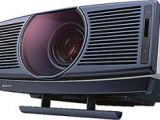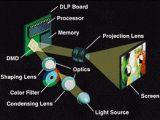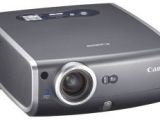Today, we return to the visual aspect as related to PC hardware. If you can't really afford a huge LCD or plasma display to enjoy all those latest HD movies and games at crystal-resolutions, you can always look into digital video projectors. The latest projector technologies offer good HD support and there's no doubt about it that these devices, compared to LCDs and plasma displays, can provide wider viewing areas. This article will explore the current digital video projection technologies, providing pros and cons for each.
Mind projection A digital video projector takes a video signal coming from PCs, DVD players or game consoles and projects the corresponding image on a relatively large projection screen or wall using a lens system. These devices usually use a very bright and light beam to project the image, with the latter being able to correct any curves, blurriness, and aliasing with the aid of predefined settings. Video projectors target conference room presentations, classroom training, and home theater applications.
Portable projectors support resolutions that include the SVGA (800?600 pixels), XGA (1024?768 pixels), and 720p (1280?720 pixels) standards. The latest projectors can also deal with the highest 1080p and 1080i HD resolutions. As prices may vary according to supported resolutions, this is not the single factor that determines the final cost of digital projectors. Other important factors are the light output, acoustic noise output, and contrast. Take into consideration that a projector with a higher light output (measured in lumens) is required for a larger screen or a room with a higher amount of ambient light. A rating of 1000 to 1500 ANSI lumens or lower is suitable for smaller screens with controlled lighting or low ambient light. Between 1500 and 3000 lm it's suitable for medium-sized screens with some ambient light or dimmed light. A total of over 3000 ANSI lm is the typical requirement for very large screens in a large room with no lighting control.
The projected image size is also important; because the total amount of light does not change and thus, as size increases, brightness decreases. Image sizes are typically measured in linear terms. For example, increasing the diagonal measure of the image by 25 % reduces the image brightness by 35 per cent; an increase of 41 per cent reduces brightness by more than half.
It is generally agreed that a good film projector loaded with a pristine film print produces a fantastic, vibrant picture. But there's an annoying problem to all this: every time you play the movie, the film quality drops a little, as each usage adds hundreds of minute scratches and bits of dirt. Accordingly, it is said that a projected digital movie is inferior to a pristine film print, but, while the quality of a film print gradually downgrades, a digital movie looks the same every time you show it.
These are the general characteristics that you should be aware of. Let us now see what technologies one may find inside present-day digital projectors.
Mutated CRT old-timers CRT projectors use small, high-brightness CRTs as the image generating element. The generated image is traditionally focused and enlarged onto a screen using a lens kept in front of the CRTs. This technology is quite obsolete, but one may still find color CRT projectors that feature three separate CRTs (one for each primary color) with their own corresponding lenses. The red, green and blue portions of the incoming video signal are processed and split in order to be sent to the corresponding CRT. Then, each of the three separate images is focused by the three lens systems and the complete color picture appears on the screen.
What are the advantages of this technology? o The CRT is known for its long life, typically comparable to the one of a normal television picture tube. o Good to very good color resolution, brightness and picture size may be achieved. o Unlike lamp-based projectors, this technology needs little to no maintenance. o Deep black levels - the black color level is superior to dark gray tones that are common with other technologies.
However, there are some disadvantages, too: o The device itself tends to be bulky and heavy (reduced portability) and this is determined by the included CRTs. o Brightness levels are relatively low - the room has to be completely dark and eyes of viewers coming from a daylight environment have to adapt to the darkness for a minute or two before image details can be seen. o The overall color is unevenly mixed due to the fact that the projected picture is optimized for the central in-focus area of the screen, while towards the edges it tends to split into the three individual colors. Furthermore, this leads to focus problems. Newer models include sophisticated circuitry in order to compensate for this. o It is usually more expensive than other technologies.
"Soaked" image quality Recent LCD projectors usually include three separate LCD panels, one each for the red, green, and blue components of the processed video signal. White light from a halogen lamp, which outputs an ideal color temperature and a broad spectrum of color is split by an included prism into the three primary colors. This kind of lamps also have the property of producing an extremely large amount of light within a small area, on average for current projectors of 2,000-4,000 ANSI lumens. As light passes through the three LCD panels, individual pixels can be turned on to allow light to pass, or turned off to block the light, as if each little liquid crystal pixel were equipped with a blind. This process modulates the light and produces the image that is projected onto the screen with the aid of millions of different shades from each color LCD panel.
LCD projectors are much smaller and much more portable than previous technologies. The LCD projector works best with a white or gray surface. White surfaces are more suitable for natural color tones, while gray surfaces excel at higher contrast rates.
Mirror World In DLP (Digital Light Processing) projectors, the image is created by arrays of microscopic mirrors laid out in a matrix on a semiconductor chip, known as a Digital Micromirror Device (DMD). Each of these mirrors represents one pixel in the final projected image. The number of mirrors corresponds to the resolution of the projected image. Thus, one may find 800x600, 1024x768, 1280x720, and 1920x1080 resolution matrices with today's DMDs.
The mirrors can be repositioned as fast as thousands of times per second in order to reflect light either through the lens or onto a heat sink. The rapid repositioning of the mirrors (essentially switching between 'on' and 'off') allows the DMD to vary the intensity of the light being reflected out through the lens, this way producing black and gray shades. What about those millions of colors? Single DMD chips produce color by placing a spinning color wheel between the lamp and the DMD. The color wheel is usually divided into four sectors: the primary colors: red, green, and blue, and an additional clear section (transparent or alpha) to boost brightness. Since the alpha section reduces color saturation drastically, in some models it may be effectively disabled, and in others it is omitted altogether. Some projectors may use additional colors (for example, yellow). The red, green, and blue images are displayed sequentially at a sufficiently high rate so that the observer sees a composite "full color" image in around 30 frames per second. In early models, this was one rotation per frame. Later models spin the wheel at two or three times the frame rate, and some also repeat the color pattern twice around the wheel, meaning the sequence may be repeated up to six times per frame. The latest DMD models have replaced halogen lamps with more powerful LEDs, which provide an improved refresh rates.
In addition, one could also find three-chip DLP projectors. These use a prism to split light from the lamp, and each primary color of light is then routed to its own DMD chip, then recombined and routed out through the lens. Three-chip DLP projectors can process finer gradations of shade and color than one-chip projectors, because each color has a longer time available to be modulated within each video frame.
Here is a list of DLP improvements over the other technologies:
- Support for 1080p HD resolution - Perfect geometry and excellent grayscale linearity - Greater light outputs (especially in LED models). - Less "screen door effect" than with LCD projectors.
And the unavoidable problems:
- In single-chip designs, some viewers are bothered by the color artifact known as the "rainbow effect." - Some devices may produce annoying noise due to an existing cooling fan. - Silk screen effect. - Error-diffusion artifacts caused by averaging a shade over different pixels, since one pixel cannot render the shade exactly. - Response time in modern video games may be affected by upscaling lag. While all HDTVs have some lag when upscaling lower resolution input to their native resolution, DLPs are commonly reported to have noticeably longer delays. Newer consoles such as the Xbox 360 and Playstation 3 do not have this problem as long as they are connected with HD-capable cables.
The hybrid Liquid crystal on silicon (LCoS) is a reflective technology similar to DLP projectors; however, it uses liquid crystals instead of individual mirrors. By way of comparison, LCD projectors use transmissive LCD chips, allowing light to pass through the liquid crystal. In LCoS, liquid crystals are applied directly to the surface of a silicon chip coated with an aluminum-based layer. This technology is also used in conjunction with high definition displays. The two technologies that are currently largely adopted are the LCD and DLP projector technology. LcoS technology will eventually become the standard in the near future and it will also be more affordable than the other competing technologies.
Well then, that much about digital video projectors. Next week, network devices can hardly wait to be analyzed, so stick around.

 14 DAY TRIAL //
14 DAY TRIAL // 




